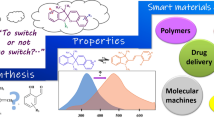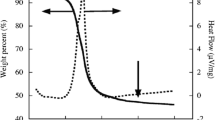Abstract
Bis-(8-hydroxyquinoline) mercury nanoribbons with average width of 300 nm, thickness of 50 nm and length of up to tens of micrometers were synthesized by a facile solvothermal method. X-ray powder diffraction and Fourier transform infrared spectrum were employed to determine their structure. The conductivity of a bundle of nanoribbons was also measured, which exhibited linear current-voltage characteristics and excellent photoresponse to light, indicating their potential applications in photoswitch nano-devices in the future.
Similar content being viewed by others
References
Chiu J J, Wang W S, Kei C C, Perng T P. Tris-(8-hydroxyquinoline) aluminum nanoparticles prepared by vapor condensation. Applied Physics Letters, 2003, 83(2): 347–349
Hu J S, Ji H X, Cao A M, Huang Z X, Zhang Y, Wan L J, Xia A D, Yu D P, Meng X M, Lee S T. Facile solution synthesis of hexagonal Alq3 nanorods and their field emission properties. Chemical Communications (Cambridge), 2007, (29): 3083–3085
Chiu J J, Kei C C, Perng T P, Wang W S. Organic semiconductor nanowires for field emission. Advanced Materials, 2003, 15(16): 1361–1364
Liu H B, Zhao Q, Li Y L, Liu Y, Lu F S, Zhuang J P, Wang S, Jiang L, Zhu D B, Yu D P, Chi L F. Field emission properties of large-area nanowires of organic charge-transfer complexes. Journal of the American Chemical Society, 2005, 127(4): 1120–1121
Kastler M, Pisula W, Laquai F, Kumar A, Davies R J, Baluschev S, Garcia-Gutierrez M C, Wasserfallen D, Butt H J, Riekel C, Wegner G, Mullen K. Organization of charge-carrier pathways for organic electronics. Advanced Materials, 2006, 18(17): 2255–2259
Cho C P, Yu C Y, Perng T P. Growth of AlQ3 nanowires directly from amorphous thin film and nanoparticles. Nanotechnology, 2006, 17(21): 5506–5510
Xia Y N, Yang P D, Sun Y G, Wu Y Y, Mayers B, Gates B, Yin Y D, Kim F, Yan Y Q. One-dimensional nanostructures: synthesis, characterization, and applications. Advanced Materials, 2003, 15(5): 353–389
Zhang X J, Jie J S, Zhang W F, Zhang C Y, Luo L B, He Z B, Zhang X H, Zhang W J, Lee C S, Lee S T. Photoconductivity of a single small-molecule organic nanowire. Advanced Materials, 2008, 20(12): 2427–2432
Hu J S, Guo Y G, Liang H P, Wan L J, Jiang L. Three-dimensional self-organization of supramolecular self-assembled porphyrin hollow hexagonal nanoprisms. Journal of the American Chemical Society, 2005, 127(48): 17090–17095
Zhao Y S, Fu H B, Peng A D, Ma Y, Xiao D B, Yao J N. Low-dimensional nanomaterials based on small organic molecules: preparation and optoelectronic properties. Advanced Materials, 2008, 20(15): 2859–2876
Zhang X J, Zhang X H, Zou K, Lee C S, Lee S T. Single-crystal nanoribbons, nanotubes, and nanowires from intramolecular charge-transfer organic molecules. Journal of the American Chemical Society, 2007, 129(12): 3527–3532
An B K, Lee D S, Lee J S, Park Y S, Song H S, Park S Y. Strongly fluorescent organogel system comprising fibrillar self-assembly of a trifluoromethyl-based cyanostilbene derivative. Journal of the American Chemical Society, 2004, 126(33): 10232–10233
Zhao L Y, Yang W S, Luo Y, Zhai T Y, Zhang G J, Yao J N. Nanotubes from isomeric dibenzoylmethane molecules. Chemistry—A European Journal, 2005, 11(12): 3773–3778
Zhao Y S, Xiao D B, Yang W S, Peng A D, Yao J N. 2,4,5- triphenylimidazole nanowires with fluorescence narrowing spectra prepared through the adsorbent-assisted physical vapor deposition method. Chemistry of Materials, 2006, 18(9): 2302–2306
Tang C W, VanSlyke S A. Organic electroluminescent diodes. Applied Physics Letters, 1987, 51(12): 913–915
Mitchell K, Ibers J A. Rare-earth transition-metal chalcogenides. Chemical Reviews, 2002, 102(6): 1929–1952
Xu C Q, Zhang Z C, Ye Q. A novel facile method to metal sulfide (metal = Cd, Ag, Hg) nano-crystallite. Materials Letters, 2004, 58(11): 1671–1676
Wang X H, Shao M W, Shao G, Wang S W. Tris(8-hydroxyquinoline) aluminum nanoribbons: facile solvothermal preparation and photoconductivity studies. Journal of Nanoscience and Nanotechnology, 2009, 9(8): 4709–4714
Chen W, Peng Q, Li Y D. Luminescent bis-(8-hydroxyquinoline) cadmium complex nanorods. Crystal Growth & Design, 2008, 8(2): 564–567
Pan H C, Liang F P, Mao C J, Zhu J J, Chen H Y. Highly luminescent zinc(II)-bis(8-hydroxyquinoline) complex nanorods: sonochemical synthesis, characterizations, and protein sensing. Journal of Physical Chemistry B, 2007, 111(20): 5767–5772
Hesse R. Indexing powder photographs of tetragonal, hexagonal and orthorhombic crystals. Acta Crystallographica, 1948, 1(4): 200–207
Lipson H. Indexing powder photographs of orthorhombic crystals. Acta Crystallographica, 1949, 2(1): 43–45
Tackett J E, Sawyer D T. Properties and infrared spectra in the potassium bromide region of 8-quinolinol and its metal chelates. Inorganic Chemistry, 1964, 3(5): 692–696
Tang Q X, Li H X, Liu Y L, Hu W P. High-performance air-stable ntype transistors with an asymmetrical device configuration based on organic single-crystalline submicrometer/nanometer ribbons. Journal of the American Chemical Society, 2006, 128(45): 14634–14639
Li Q H, Wan Q, Liang Y X, Wang T H. Electronic transport through individual ZnO nanowires. Applied Physics Letters, 2004, 84(22): 4556–4558
Author information
Authors and Affiliations
Corresponding author
Rights and permissions
About this article
Cite this article
Liu, L., Shao, M. & Wang, X. Bis-(8-hydroxyquinoline) mercury nanoribbons: preparation, characterization and photoconductivity. Front. Optoelectron. China 3, 228–231 (2010). https://doi.org/10.1007/s12200-010-0113-x
Received:
Accepted:
Published:
Issue Date:
DOI: https://doi.org/10.1007/s12200-010-0113-x




